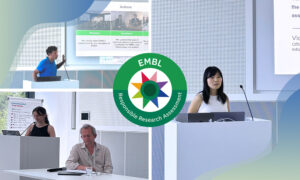
Celebrating 40 years of leading life science
More than 1,000 staff and alumni from around the world came together at EMBL Heidelberg to celebrate the Lab’s 40th Anniversary Reunion, 18–19 July 2014. A special programme combining reunion activities and the annual Lab Day celebration was co-organised by the Alumni Association and Lab Day Committee, making it the largest community event in EMBL’s history.

Unconventional wisdom
EMBL Director General Iain Mattaj opened by revealing a little-known fact about the Lab: its initial efforts to attract senior scientists after its founding in 1974 floundered. As a back-up plan, the founders set their sights on recruiting young scientists just starting their careers. That focus on training has remained a core mission, and given rise to EMBL’s unique ‘family’ spirit.
Giulio Superti-Furga, Chair of the EMBL Alumni Association, declared that the event was not going to be a traditional conference: “You’re going to be shouting and voting and participating!” he said, thanks to the ‘experimental’ format devised to keep proceedings engaging and interactive.
Friday’s programme consisted of five sessions highlighting different research areas at EMBL: ‘ATC & G’ (genomics), ‘X Y and Z’ (structure), ‘Ab aB’ (developmental biology), ‘Ones and Zeroes’ (bioinformatics) and ‘Wave & Length’ (cell biology). For each session, four speakers and a moderator took the audience through the past, present and future of each discipline, in a series of presentations that combined ‘hard’ scientific research with more contextual talks.
Work and play
A common refrain was EMBL’s tradition of pushing the envelope of scientific possibility. Alumni Christiane Nüsslein-Volhard and Eric Wieschaus, both of whom would later win the Nobel Prize, were “searching for developmental genes [in the early 1970s], a time when many people did not even believe that genes were important for development,” said alumnus Denis Duboule. “We’re still asking the same question: how a genotype gives rise to a particular phenotype,” added Angus Lamond, “But now we can ask that question and others in much more exciting ways.”
Adding to the festive spirit, surprise slides often featured speakers in their younger days (with obligatory embarrassing hairdos). The first generation of alumni enjoyed reminiscing about their days at the Lab, while the next generation gained a glimpse into EMBL’s heritage. “It was fun to see that the group leaders, who we all think of as serious scientists, used to have a lot of fun,” said Valentine Svensson, a PhD student in the Teichmann group at EMBL-EBI.
The evening concluded with a feast of the same menu served at the 1973 signing of the accord to establish EMBL (officially ratified on 4 July 1974, when the Lab became a legal entity). A special light show, projected onto the EMBL Advanced Training Centre, rounded off the first day’s festivities.
Recognising excellence
The following morning, five speakers focused on technological innovation and development – a guiding principle in the founding of EMBL. A moment of silence was observed to remember Christian Boulin, Director of Core Facilities and Services, who passed away in April 2014. Highlights included innovative imaging techniques, the achievements of EMBL’s synchrotron facilities at PETRA and ESRF, and bilateral initiatives between Hamburg and Grenoble.
Alumni reunited with former colleagues over coffee at the lab group reunions, some of whom hadn’t seen each other for over 30 years. Many toured the exhibition of fun and creative Lab Day posters, ranging from the Kinderhaus’ first prize-winning giant papier-mâché tiger to a high-resolution microscopy photo booth by the Ries lab. Others hoped for some molecular matchmaking in carefully orchestrated rounds of scientific speed dating.
Kai Simons presented the John Kendrew Young Scientist Award, given annually to an early-career researcher whose work exemplifies excellence in basic research and science communication. This year’s winner, Martin Jinek, presented his work investigating the Cas9 system’s “potential to engineer genomes virtually at will” – Jinek has co-founded a biotech company, Caribou Biosciences, to further pursue its possibilities.
The family forges ahead
Taking the stage again, Giulio Superti-Furga marveled at how quickly EMBL evolved from “fringe pioneers” to a robust community aware that it “holds the future of humanity in its hands.” Alongside its partner organisations, EMBO and EMBC, the Lab is a beacon of progress in molecular life science in Europe and beyond – he presented a symbolic torch to Head of Alumni Relations and reunion organiser Mehrnoosh Rayner, who held it aloft to thunderous applause.
Celebrations concluded with a special dinner in honour of Claus Himburg, newly retired head chef of the EMBL Heidelberg canteen, after which members of the EMBL family, past and present, danced the night away.


